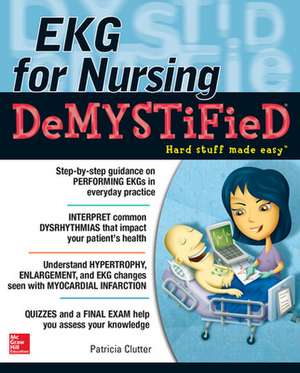EKG's for Nursing Demystified
Autor Pat Clutteren Limba Engleză Paperback – 16 noi 2014
The quick and easy way to master EKG procedures and use your knowledge in real-world situations
If you're looking for a fun, fast review that boils EKGs down to the most essential, must-know points your search ends here! EKG for Nursing Demystified is a thorough yet concise overview of this medical test, complete with time-proven techniques, facsimiles of EKG strips, and numerous clinical cases. You will learn how to interpret hypertrophy and enlargement, arrhythmias, conduction blocks, Pre-excitation syndromes, myocardial infarction and more, so you have the knowledge to help your patients as a student and as a nurse once you start your career.This fast and easy guide offers:
- Learning objectives at the beginning of each chapter
- A foundation in EKG topics
- A final exam at the end of the book
- A time-saving approach to performing better on an exam or at work
Preț: 243.62 lei
Preț vechi: 256.44 lei
-5% Nou
Puncte Express: 365
Preț estimativ în valută:
46.62€ • 48.80$ • 38.57£
46.62€ • 48.80$ • 38.57£
Carte disponibilă
Livrare economică 15-29 martie
Preluare comenzi: 021 569.72.76
Specificații
ISBN-13: 9780071801690
ISBN-10: 0071801693
Pagini: 368
Dimensiuni: 185 x 231 x 20 mm
Greutate: 0.54 kg
Editura: McGraw Hill Education
Colecția McGraw Hill / Medical
Locul publicării:United States
ISBN-10: 0071801693
Pagini: 368
Dimensiuni: 185 x 231 x 20 mm
Greutate: 0.54 kg
Editura: McGraw Hill Education
Colecția McGraw Hill / Medical
Locul publicării:United States
Cuprins
Table of Contents
1. Chapter 1: Introduction
•Background on ECG
oPurpose
oClinical uses
oHealthcare workers who can perform ECG
CNA, MA, cardiovascular technologists and technicians, RN, NP, PA, MD, DO, DC
Certification
•Chapter synopsis
2. Chapter 2: Patient Care
•Preparing patient for procedure
oConsent
oExplanation of procedure
oPatient history and physical
•Care of special populations (elderly, pediatric, pregnant, etc.)
3. Chapter 3: Cardiovascular System Anatomy and Physiology
•Anatomy
•Physiology
oElectrical impulses
oCells of the heart
4. Chapter 4: Cardiac Monitoring Basics
•How does cardiac monitoring work?
•Equipment
oLeads
oPlanes
oPaper
oEquipment problems
•Types of ECG
o12-lead
oRhythm strip
•Patient preparation
Chapter 5: Waves, Complexes, and Straight Lines
•Naming of waves, complexes, and straight lines
•Orientation of waves of normal ECG
•X-step method of interpreting rhythm strip
Chapter 6: Axis and Hypertrophy
•Axis Deviation
•Atrial Enlargement
•Ventricular Hypertrophy
Chapter 7: Myocardial Infarction
•Diagnosis criteria
•ECG evolution
•Angina
•Stress Test
Chaper 8: Conduction Blocks
•Sinus node block
•AV block
•Bundle branch block
Chapter 9: Arrhythmias
•Atrial arrhythmias
•Ventricular arrhythmias
•Junctional arrhythmias
Chapter 10: Factors that Influence ECG
•Electrolyte disturbances
•Hypothermia
•Athletic activity
•Medications
•Cardiac and pulmonary disorders
•Central nervous system disorders
Appendices
•Final Exam Questions
•Interpretation Exercises
oSimilar strip interpretation
•ECG At-a-Glance
•Glossary
•Selected references
•Index
1. Chapter 1: Introduction
•Background on ECG
oPurpose
oClinical uses
oHealthcare workers who can perform ECG
CNA, MA, cardiovascular technologists and technicians, RN, NP, PA, MD, DO, DC
Certification
•Chapter synopsis
2. Chapter 2: Patient Care
•Preparing patient for procedure
oConsent
oExplanation of procedure
oPatient history and physical
•Care of special populations (elderly, pediatric, pregnant, etc.)
3. Chapter 3: Cardiovascular System Anatomy and Physiology
•Anatomy
•Physiology
oElectrical impulses
oCells of the heart
4. Chapter 4: Cardiac Monitoring Basics
•How does cardiac monitoring work?
•Equipment
oLeads
oPlanes
oPaper
oEquipment problems
•Types of ECG
o12-lead
oRhythm strip
•Patient preparation
Chapter 5: Waves, Complexes, and Straight Lines
•Naming of waves, complexes, and straight lines
•Orientation of waves of normal ECG
•X-step method of interpreting rhythm strip
Chapter 6: Axis and Hypertrophy
•Axis Deviation
•Atrial Enlargement
•Ventricular Hypertrophy
Chapter 7: Myocardial Infarction
•Diagnosis criteria
•ECG evolution
•Angina
•Stress Test
Chaper 8: Conduction Blocks
•Sinus node block
•AV block
•Bundle branch block
Chapter 9: Arrhythmias
•Atrial arrhythmias
•Ventricular arrhythmias
•Junctional arrhythmias
Chapter 10: Factors that Influence ECG
•Electrolyte disturbances
•Hypothermia
•Athletic activity
•Medications
•Cardiac and pulmonary disorders
•Central nervous system disorders
Appendices
•Final Exam Questions
•Interpretation Exercises
oSimilar strip interpretation
•ECG At-a-Glance
•Glossary
•Selected references
•Index





